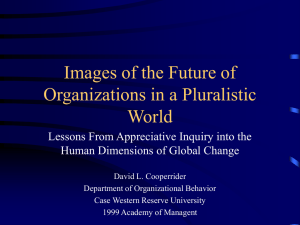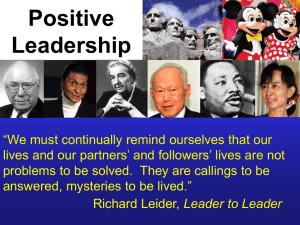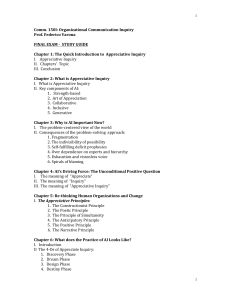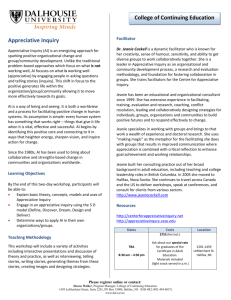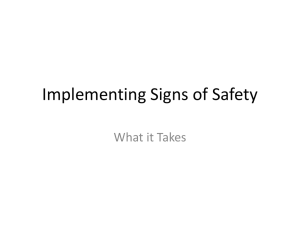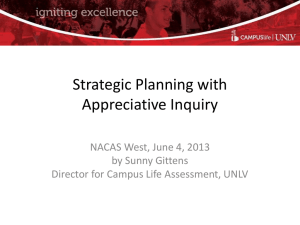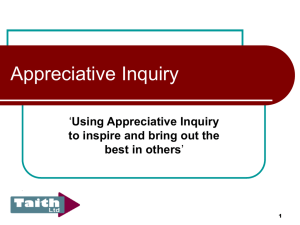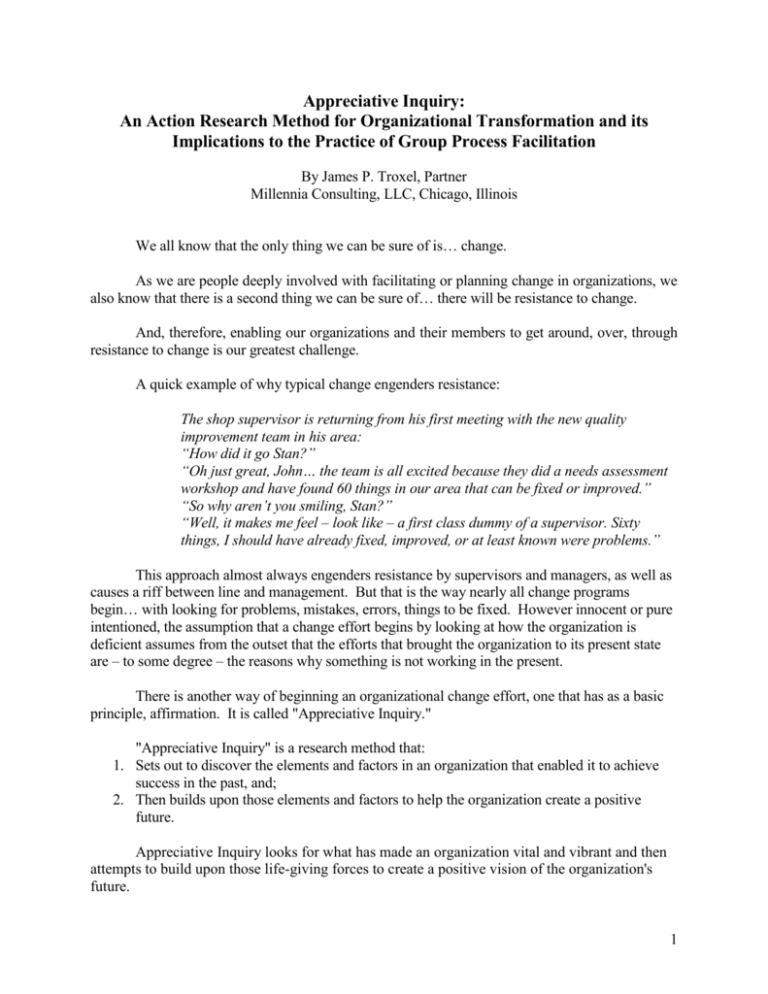
Appreciative Inquiry:
An Action Research Method for Organizational Transformation and its
Implications to the Practice of Group Process Facilitation
By James P. Troxel, Partner
Millennia Consulting, LLC, Chicago, Illinois
We all know that the only thing we can be sure of is… change.
As we are people deeply involved with facilitating or planning change in organizations, we
also know that there is a second thing we can be sure of… there will be resistance to change.
And, therefore, enabling our organizations and their members to get around, over, through
resistance to change is our greatest challenge.
A quick example of why typical change engenders resistance:
The shop supervisor is returning from his first meeting with the new quality
improvement team in his area:
“How did it go Stan?”
“Oh just great, John… the team is all excited because they did a needs assessment
workshop and have found 60 things in our area that can be fixed or improved.”
“So why aren’t you smiling, Stan?”
“Well, it makes me feel – look like – a first class dummy of a supervisor. Sixty
things, I should have already fixed, improved, or at least known were problems.”
This approach almost always engenders resistance by supervisors and managers, as well as
causes a riff between line and management. But that is the way nearly all change programs
begin… with looking for problems, mistakes, errors, things to be fixed. However innocent or pure
intentioned, the assumption that a change effort begins by looking at how the organization is
deficient assumes from the outset that the efforts that brought the organization to its present state
are – to some degree – the reasons why something is not working in the present.
There is another way of beginning an organizational change effort, one that has as a basic
principle, affirmation. It is called "Appreciative Inquiry."
"Appreciative Inquiry" is a research method that:
1. Sets out to discover the elements and factors in an organization that enabled it to achieve
success in the past, and;
2. Then builds upon those elements and factors to help the organization create a positive
future.
Appreciative Inquiry looks for what has made an organization vital and vibrant and then
attempts to build upon those life-giving forces to create a positive vision of the organization's
future.
1
Note: This article draws heavily upon my own experiences with this research method and the writings of David
Cooperrider and Suresh Srivastva, two of the key architects of the Appreciative Inquiry approach as designed and
implemented by the staff of the Weatherhead School of Management's Department of Organizational Behavior at
Case Western Reserve University in Cleveland, Ohio.
In the film “Lawrence of Arabia” just before heading off for Arabia, the T. E. Lawrence
character, played by Peter O’Toole, is asked what he will do when he gets there, how he will get
the warring tribes of Arabia to join together to fight the Turks, Britain’s enemy in the Middle
East during World War One. In the film, Lawrence says: “ I will appreciate the situation.” If you
have seen the film and still recall it to mind, you should be able to see how the theory of
Appreciative Inquiry matches up against the intuitive and contextual approach of Lawrence.
Appreciation
1.
A feeling or expression of gratitude
2.
A favorable opinion of something
3.
Recognition and liking of something’s qualities
4.
A full understanding of the meaning and importance of something
5.
An increase in value, especially over time
Encarta® World English Dictionary © 1999 Microsoft Corporation. All rights reserved. Developed for
Microsoft by Bloomsbury Publishing Plc.
The “what’s and how’s” of Appreciative Inquiry
Appreciative Inquiry uses "understanding-through-empathy" during first-hand interviews
with stakeholders of the organization. Its bias is toward the direct interaction with and observation
of the people in an organization rather than a detached analysis of facts, figures, charts, benchmark
comparisons, and discussions with executives only.
It is a case study and contextual method explicitly aimed at attempting to isolate, magnify,
and document the “life-giving forces” involved in the cooperative action and collective existence
of an organization.
Life giving forces are the unique values, structures, and processes that make the
very existence of an organization possible. They are both the élan vital – the energy
that gives an organization breath and an organization’s building blocks that give it
form and substance — ideas, beliefs and values, as well as structures, practices or
procedures.
It is "appreciative" because it looks for what has enabled an organization to exist and thrive
rather than to look for problems or weaknesses — to identify what is not working in order to fix it.
Instead of seeing the organization in some way being deficient, faulty or in some way defective, AI
researchers look at the organization as being already full and complete and having the wherewithal
to complete its mission.
2
It is an "inquiry" because it relies heavily upon close collaboration with the organization’s
members as the primary source of information by drawing out people’s stories of “work life”
within the organization. Then, following that inquiry, by portraying the reoccurring themes
collected from interviews, and immersing oneself into the life of the organization, a researcher is
able to detect patterns and properties of the organization that have kept it alive and provide a basis
for vitality for its future.
"Appreciative Inquiry" as Action Research
Appreciative Inquiry is a form of action research of organization and social life.
Researchers and open systems theorists Eric Trist, Fred and Merrelyn Emery, Russ Ackoff, Chris
Argyris, and many others have documented action research’s capacity to transform the objects of
its research. The Tavistock Institute in London became famous for its development of action
research from the 1940s onward.
Their work has revealed that action research has a "generative capacity," a "capacity to
challenge the guiding assumptions of the culture, to raise fundamental questions regarding
contemporary social life, to foster reconsideration of that which is 'taken for granted' and thereby
furnish new alternatives for social actions" (Gergen, 1978). Appreciative Inquiry has this capacity
in that organization members – through in-depth interviews – are given the opportunity to retell the
story about their organization and its future directions.
Part of the task of action research is to produce a theory of change, which emerges from the
change process itself. Appreciative Inquiry is "grounded theory building" (Glaser and Strauss,
1967) in the sense that the operating framework and images of the future of the organization
emerge from the stuff of the organizational life itself.
While most organizational members are not consumed with the theoretical base of their
group, they have nonetheless, formed - consciously or unconsciously - a contextual framework
with certain assumptions about the world and its needs, a series of operating values that guide their
thinking and acting, an "in-house" language that allows them to communicate with ease, as well as
a vision of the future. This framework supports the corporate culture of the organization.
Appreciative Inquiry can surface the underlying non-negotiable values that hold an organization
together and point it towards its future.
Guiding Perspectives of Appreciative Inquiry
The perspective that guides Appreciative Inquiry begins the with the notion that every
organization operates out of an image - a mental picture or model - of itself, of the world around it
and of the future. Sometimes these images are conscious, but often they are not. When an
organization is founded, the images are clear. During the growth of an organization, the images
generally remain clear. In established organizations, frequently the image becomes murky.
Members may have lost their anticipatory memory of why they are in being, their initial calling.
Their original allure may have become opaque in the struggles for survival. Unfortunately new
members are rarely provided access to the founding images of the organization.
3
To paraphrase Fred Polak (1973), the rise and fall of images of the future precedes or
accompanies the rise and fall of organizations. As long as an organization's image is positive and
flourishing, the flower of the organization is in full bloom. Once the image begins to decay and
lose its vitality, however, the organization does not survive long.
A change in perspective example: During the 1950s and 1960s Cleveland, Ohio
was a vibrant, vital industrial city with a positive view of itself. During the 1970s
and 1980s the onslaught of the success of Japanese autos, the rising costs of fuel,
and cutthroat competition in steel, meant the loss of thousands of jobs in Cleveland.
It became to itself and the nation – the “Mistake on the Lake.” In the early 1990’s
people in Cleveland began to change their view of themselves and their city. It may
not be San Francisco, LA, or New York but it has again become a vibrant city where
performers and visitors to its Rock and Roll Hall of Fame enjoy staying an extra
day.
Appreciation —Kolb (1984) states, "Appreciation is a process of affirmation. Unlike criticism,
which is based on skepticism and doubts, appreciation is based on belief, trust, and conviction.
And from this affirmative embrace flows a deeper fullness and richness of experience."
Therefore, what the researcher looks for first in analyzing organizational life is not what are
the problems with this organization, but rather, what are its gifts - the building blocks of the
organization. They may be ideas, beliefs or values as well as structures, practices or procedures.
What you see is what you will work toward manifesting — Relying then upon these gifts as
energizing capacity, the research extends into the future what the organization might look like.
This has been termed the activity of crafting provocative propositions. Envisioning provocative
new futures for an organization relies upon that assumption that human systems are largely belief
or vision fulfilling in character, meaning, "they exhibit an observable and largely automatic
tendency to evolve in the direction of positive anticipatory images of the future" (Cooperrider,
1990).
"The spirit of Appreciative Inquiry is to be found in one of the most ancient archetypes or
metaphorical symbols of hope and inspiration that humankind has ever known - the miracle and
mystery of being.... In the same way that birth of a living, breathing, loving, thinking human being
is an inexplicable mystery, so too it can be said in no uncertain terms that 'organizing is a miracle'
of cooperative human interaction, of which there can never be final explanation… the action
researcher is drawn to affirm, and thereby illuminate, the factors and forces involved in organizing
that serve to nourish the human spirit" (Cooperrider & Srivastva, 1987).
In other words, Appreciative Inquiry is grounded in an "organizational theory of
affirmation" which, paraphrasing Cooperrider (1990), has as some of its key elements the
following:
4
1. When it comes to understanding organizational existence, there is no better clue to the
organization's overall well being than its guiding images of the future - its vision of itself
and the world. Organizations exist because its stakeholders that govern and maintain them
carry in their minds and hearts some sort of shared positive projection about what the
organization is, how it will function, and what it might become.
2. No matter what its previous history is, virtually any pattern of organizational action is open
to alteration and reconfiguration.
3. To the extent that an organization's imaginative projections are the key to their current
conduct, organizations are free to seek transformations of themselves by replacing current
images with images of a new and better future.
4. Organizations are heliotropic in character. That is they grow toward the light, toward a
positive vision of the future. Positive imagery and hence heliotropic movement is endemic
to organizational life. Consequently, organizations have the capacity to create their own
realities and their own futures.
5. Conscious examination, recall, and creation of positive imagery are viable options for
organizations. The more an organization focuses on positive imagery, the better it will
become; there is an observable self-reinforcing, imaginal educative effect of affirmation.
Affirmative competence is the key to the self-organizing system.
6. The key to an organization having a hope-filled future is to be perpetually self-reaffirming.
The challenge to organizational transformation is to discover the processes through which
an organization's declarations of its past can be left behind and better ones for the future be
developed. The process of visioning is more important than the content of the vision.
7. Every organization needs constant reaffirmation. Frequently the stakeholders of an
organization have become unconscious to that which has made the organization vital. The
original vitality needs to be awakened by a process of affirmation through a stance of
appreciative cognition. Somehow the "immensity of the commonplace" (Bruner, 1986)
needs to become transparent to all the stakeholders in order for them to believe in
themselves again.
8. Creating the conditions for organization-wide appreciation is the single most important
measure that can be taken to ensure the conscious evolution of a valued and positive future.
Through appreciation of organizational life, members of an organization learn to value not
only the life-enhancing organization itself, but also learn to affirm themselves.
Appreciative Inquiry and its process of building on the vibrant life-giving forces of an
organization, which are discovered in interviews and story telling of its members, allow them to
relate “optimal” experiences at work, similar to those researched and documented by Professor
Mihalyi Csikszentmihalyi’s in his book, Flow. A Dutch collaborator of Csikszentmihalyi, Frank
Heckman has shared this example of flow in a book he co-authored with Ned Hamson (After
Atlantis: Working, Managing, and Leading in Turbulent Times). A technical support group from
a large consulting firm said of their flow experience:
“We had ten weeks to complete the project, and started two weeks late. Our objectives
were quite clear and through the high level complexity of the project our group was forced
into a continuous learning and solution seeking mode. Despite the tremendous pressures,
we were pretty soon in the groove of collaboratively and effectively deciding on all sorts of
issues all the time, moving through and around the obstacles with great conviction and a
sense that nothing could stop us. We came to call our project ‘mission impossible,’ and
5
upon completion, many of us confessed that this had been one of the most exciting and best
experiences in our professional life.” (Page 51)
The Process of Appreciative Inquiry
The appreciative mode of inquiry is a way of living with, being with, and directly
participating in the varieties of social organization. The consultant/researcher walks in with the
stance of "appreciative objectivity" - value-laden with the assumption that whatever one finds, one
will gravitate toward embracing it as inherently good and in so doing will be able to recognize its
latent possibilities for the future.
The process of Appreciative Inquiry can be simply stated in two basic steps:
1. The research task is to identify and value the best of “what is” within the organization. In
the first step the purpose of valuing is to tap into the key themes and forces important to the
organization.
2. The research task then envisions what “might be.” When the best of what is has been
identified and is valued and the values are recounted, the mind naturally begins to search
beyond this; it begins to envision new possibilities. Valuing the best of what is leads to
envisioning what might be. Envisioning means allowing oneself to be inspired by what one
sees.
Appreciative Inquiry looks for those peak moments in organizational existence when the
individuals felt most alive, effective, and potent. Then, by building on these experiences, it
describes the ideal-type ideas of what can be produced which challenge the organization to become
more than they are at their current level by visioning from the best of what already exists. The
theory behind provocative propositions is that change comes from doing more of what you are
already doing when operating at one's best. Preoccupation on the organization’s blocks, problems,
weaknesses and barriers may undermine the process of identifying the positive energy that is
required to enable the organization to move to a new level of operation.
Four Operating Principles of Appreciative Inquiry
From the above, the, four principles of Appreciative Inquiry as a form of action research
can be stated as such (Cooperrider and Srivastva, 1987; Cooperrider, 1989):
1.
Appreciative
This principle assumes that every social system "works" to some degree that it is not in a complete
state of entropy. The primary task of research, then, is to discover, describe, and explain those
social gifts, talents, innovations, however small, which serve to give "life" to the system and
activate members' competencies and energies.
2.
Applicable
Appreciative Inquiry is pragmatic. Its results are concretely beneficial to the organization under
review. An applicable organizational analysis leads to new understandings that can be used,
applied and thereby validated in action.
6
3.
Provocative
Appreciative Inquiry holds that an organization is, in fact, an open-ended indeterminate system
capable of:
Becoming more than what it is at any given moment, and
Learning how to actively take part in guiding its own evolution.
Appreciative knowledge of what is suggests what might be, and such knowledge can be used to
generate images of realistic developmental opportunities that can be experimented with on a wider
scale. In this sense, Appreciative Inquiry can be both pragmatic and visionary.
4.
Collaborative
Since the intent of Appreciative Inquiry is to identify the life-giving forces, by working with its
members, and becoming deeply familiar with the organization can it illuminate significantly those
very products of the research quest.
Members of the organizations need to be seen and treated as co-researchers. Every step in
the research should be done as jointly and consensually as possible. By doing the research in a
collaborative fashion, the other three principles are more possible to fulfill.
Hope, Challenge and Energy for Change:
Applying Appreciative Inquiry with The Institute for Cultural Affairs
I participated in an "Appreciative Inquiry" research project in 1989, as a staff member of
the Institute of Cultural Affairs (ICA). The Chicago office of the ICA, which serves the Midwest,
had been selected to be a case study for a research project designed and managed by the
Department of Organizational Behavior at Case Western Reserve University in Cleveland.
Phase 1: The ICA (Reluctantly) Joins in the AI Project
Case Western researchers, Suresh Srivastva, David Cooperrider, and Tojo Thachankary
visited with staff of the ICA in Chicago in April of 1989. Their purpose was to acquaint ICA with
the project and gain staff support for moving ahead with ICA as one of the case studies.
7
About the Institute of Cultural Affairs: The Institute of Cultural Affairs is a
The Social
Innovation
Globalorganization.
Management
Project
world-wide
private,in
non-profit
Their aim
is to develop and
methods
of individual,
community,
organizational
Researchersimplement
at Case Western
University,
in 1989,
designed and
an imaginative
scheme to investigate
development.
Their
programs
are
highly
participatory
and
are
often
conducted
"global social change organizations" to create a database on innovative management
techniques and as
in collaboration
public,inquiry
private,approach.
voluntary,David
or local
community
a means to focus
attention onwith
the other
appreciative
Cooperrider,
noted in his March
organizations.
2, 1989, letter:
". [O]ur studies are meant to include many diverse forms of organized action (social
movements, networks, global projects, interorganizational partnerships, transnational professional
activities
include
community
facilitation,toeducational
associations,Itsetc.)
that have,
as their
primary meeting
task, a commitment
serve as anresearch
agent ofand
change in the
training,
organizational
youth and women's programs,
development
of a healthier,
peacefultransformation,
world."
sustainable rural development symposia and projects, leadership training,
personalwere
development
strategicinitial
planning
conference
Four organizations
selected toworkshops,
be in the project’s
pilotseminars,
phase. In addition
to The Institute of
facilitation,
Cultural Affairs
(ICA – documentation
see box below),and
theyevaluation.
were:
The International Physicians for the Prevention of Nuclear War, who, after being in existence for five
The the
author
of this
paper,
James
Troxel,
ICA staff
memberawareness
in
years, were Note:
awarded
Nobel
Peace
Prize
in 1985
forwas
theiranefforts
in raising
about
1989.
the medical consequences of nuclear war.
The Hunger Project, established in 1977 and active in over 20 countries, and whose purpose is to
transform the prospect of ending hunger from a possibility into an opportunity that can be
realized.
The Nature Conservancy (Latin American Division), which has as its principle mission the global
preservation of natural or biological diversity.
The research process itself lasted for approximately 9 months of 1989 beginning in March. It
culminated with the presentation of the case studies to a "Social Innovations in Global Management.”
conference convened by Case Western.
Note: Global social change organizations were defined as non-profit organizations organized to promote the well
being of the entire planet with an international focus.
We were impressed with the appreciative inquiry’s philosophy since it mirrored ICA’s
organizational philosophy but hesitant about participating since as staffers and as organizational
consultants it was hard for us to believe that anyone “outside” using methods different than ours
could offer anything of value to us. We were also afraid the project would eat up staff time and
perhaps give us a product with little relevance or value for our future. In short, our reaction was
similar to that of most organizations that are not very interested in change. However, the allure of
the method’s philosophy moved us to give them a tentative "yes," subject to our reactions to an
initial round of staff interviews and briefings on how much of our time we might be committing to
the project.
Tojo Thachankary and Xiaoping Tian, both then doctoral candidates at Case Western,
conducted a first round of interviews in May 1989 to get an idea of ICA’s life giving forces and to
increase the level of receptivity for the research project. They conducted about 20 individual
interviews and asked each person three primary questions and each person was asked to draw a
picture or image of ICA:
8
1. What was your personal high point with ICA? A peak experience? (When did you feel
most alive or most a part of the ICA? What was your most rewarding experience?)
2. What for you are the basic values that you cherish most (hold most dear) that continue to
give life to the ICA?
3. What do you want the ICA in the future to be? If you could enhance one thing for further
development of the ICA as an organization, what would it be?
Each interview (nearly 140) was taped. Later, about 100 were transcribed.
About the Institute of Cultural Affairs: The Institute of Cultural Affairs (ICA) is a worldwide private, non-profit organization. Its aim is to develop and implement methods of
individual, community, and organizational development. Its programs are highly participatory
and are often conducted in collaboration with other public, private, voluntary, or local
community organizations.
Its activities include community meeting facilitation, educational research and training,
organizational transformation, youth and women's programs, sustainable rural development
symposia and projects, leadership training, personal development workshops, strategic
planning seminars, conference facilitation, documentation and evaluation.
Note: The author was an ICA staff member from its founding in 1972 until 1996.
Personal Reflections of my interview:
I remember my first interview – with Tojo Thachankary - because of my apprehension and
guardedness going in. What was he going to ask me and how would I respond? I didn’t want to
reveal “too much.” However, his first question completely overwhelmed me - I was awestruck. I
don't remember exactly what I said but I talked and rambled for about half an hour. Tojo seemed
completely absorbed in all that I was saying, only interrupting to gain clarity. His second question
seemed even more thought provoking and I talked for far longer than either of us had imagined I
would. By the time we got to the third question, Tojo was far behind in his interview schedule and
I was surely missing something important as well but I felt a rush giving another response.
I still remember the feeling I had when the interview was over: someone affirming and
appreciating my involvement with the ICA exhilarated me. I had a chance to recall, to retell my
story about what ICA had meant to me, just me. And I had been provoked into thinking about our
future in a profound sort of way.
Irish poet, John O’Donohue expresses much better than I what appreciation and affirmation
(love) calls forth in these passages from his book Eternal Echoes (pp. 11-12):
“One of the deepest desires in the human heart is to be loved for yourself
alone… Like someone who has been lost for years in a forgotten place, you
9
rejoice in being found. When you are discovered, you then discover yourself.
This infuses your whole life with new vigor and light…You discover your
creative force.”
Other colleagues reported they had had a similar kind of response. Clearly, appreciative
inquiry had tapped a deep wellspring in all of us. After about two days of interviews, Tojo and
Xiaoping had interviewed enough people to warrant meeting with all those interviewed to give us
feedback. They noted that "life giving forces" and other themes were emerging from the
interviews. Tojo wrote these on the board.
We were struck at how well these two "outsiders" had so quickly and accurately grasped
the nature and spirit of our organization - not just what we do, but who we were. We also shared
with one another our deep appreciation for “the interview” itself. Each said how the interview had
been a personal affirmation, as each had had the opportunity to tell “their story” of what the ICA
meant to them.
We quickly agreed that the interviews alone had value for the organization and that we
wanted to proceed with the full project. Since the appreciative inquiry approach requires the
process be collaborative, we formed an Appreciative Inquiry Team (AI Team) involving eight staff
members and the Case Western researchers.
Tojo and Xiaoping then "trained" the team - of which I was a member - in how to do the
interview. It is important that the interviewer be non-judgmental regarding responses given and to
only ask follow-up questions to gain clarity. This technique was well received by us since it
mirrored one of our basic techniques - the "Conversation Method" (See Spencer, 1989).
Phase II: Expanding the Field of Inquiry
When Tojo and Xiaoping returned to start the phase two of the project, they and the AI
Team interviewed every ICA staff member as well as several volunteers and Board members. This
gave us a total of about 50 completed interviews. While the interviews were being transcribed, the
AI Team met to more sharply define the draft of the ICA’s “life giving forces.”
Each team member then worked on the themes from the preliminary interview data and
identified what he or she thought were ICA’s life giving forces. The team then pooled the
individually refined life giving force themes looking for similarities and dissimilarities among
them. The “card technique” outlined in the ICA's Technology of Participation book (Spencer,
1989) was used to finally refine the life giving forces. The five life giving forces identified of the
ICA at this point were:
1. The "Faith Stance" of the ICA - of being open and affirming all of life;
2. The "Decision-Making Process of Consensus" the ICA employs;
3. The "Communitarian" nature of the ICA that binds its people together as a form of
extended family;
10
4. The "Missional" character of the organization seeing itself as service to the world;
5. The ongoing "Learning Community" nature of the organization.
The AI Team then formulated several questions to probe, during new interviews, different
aspects of each life giving force. A format was piloted, refined, and then finalized. We also
decided that to gain the most out of this process, we needed to include as many ICA stakeholders
as possible. This meant that more people and time would be involved than first planned for.
Phase III: Further refining of the life giving forces of the ICA
The AI process really took off during Phase III. While the first round of interviews were
about 30 minutes in length, the second round stretched to about 90 minutes. The intent was to
enable each person to share fuller testimony to the power of the five life giving forces as they
experienced them. In addition, because we were now sending members of the AI Team across the
Midwest to visit colleagues, supporters, donors, Board members and former staff members who
had not been in the first round, some of these interviews took nearly two hours. In a couple of
cases, small groups of colleagues met in people's living rooms and did the interview process as a
group endeavor. This proved to be nearly as effective as the individual interviews, at least for
stakeholders who were less involved in ICA activities.
Over 100 people involved with the ICA had been interviewed when this phase had ended.
All those were given the opportunity to tell their stories reported feeling profound appreciation.
Rich material was collected, taped, and transcribed by AI Team members.
The affirming positive energy of the appreciative inquiry interviews had been released
throughout the ICA Heartland network. The appreciative inquiry process itself gave the network a
new sense of hope in the future. This was a period of decentralization for the organization and the
appreciative inquiry process restored a sense of confidence in our ability to affect our destiny.
In retelling what had made us great, we rediscovered within ourselves the capacity to claim
our greatness for the future, in new forms and manifestations.
Phase IV: Harvest time
It was now time of gleaning lessons and implications for the present and the future. We
planned an Appreciative Research Carnival and scheduled it for early August 1989. In preparation,
a flurry of transcriptions was completed and the AI Team met to review all of the work to date. We
identified key quotes to illustrate each life giving force. The quotes were arranged under each of
the life giving forces and further subdivided into eight "organizational factors":
1.
Strategy and Task
2.
Organizational Structure
3.
Operational Practices
4.
Leadership
5.
Decision Making Processes
11
6.
Interpersonal Relations
7.
Basic Beliefs and Values
8.
Communication.
Every one who had been interviewed was invited to the Carnival - 30 staff and colleagues of the
ICA from across the Midwest attended.
The Carnival’s chief purpose was to gain consensual validation of the final draft of the
ICA’s Life Giving Forces and to identify "Provocative Propositions" for the future of each of them.
During the second round of interviews, each respondent was asked to describe how they saw each
Life Giving Force in the future. This was the basis of identifying the future of the ICA by
extending the best of the past into the future.
The "Carnival" theme highlighted the celebration, affirming aspect of the research. During
ICA’s Carnival each participant was asked to read a sampling of interview transcripts through the
screen of the 8 organizational factors and highlight what they found significant. Then, Carnival
participants were divided into groups to work on a different Life Giving Force. Each group was
further sub-divided into teams whose task was to draft final Life Giving Force statements. This was
done to obtain clarity on the Life Giving Forces. The sub-teams then met, discussed similarities
and differences, and came to agreement on “their” final draft. Under each category sample quotes
were selected from the transcribed interviews to give “life and voice” to the Life Giving Force.
The next step during Carnival was to create the Provocative Propositions. A Provocative
Proposition is a statement that bridges the best of "what is" with one's own intuition of "what might
be.” It builds on the Life Giving Forces and releases additional energy to make visions a reality. A
minimum of 40 Provocative Propositions were written - at least one for each of the eight
organizational factors under each of the five Life Giving Forces.
A Provocative Proposition contains three aspects of organizational life:
1.
2.
3.
Novelty: It should bring an element of surprise, challenge, and
intrigue.
Continuity: It suggests that whatever new strategies and changes
are planned they must ensure that continuity from old to the new is
maintained.
Transition: It calls for making sure that there is a smooth transition
from the familiar to the unfamiliar and that the change is not felt so
abruptly that continuity or novelty is lost.
The mental/social point at which these factors intersect is where a true provocative
proposition is most likely to emerge.
12
Carnival participants were given an opportunity to be bold, creative and inspiring about
their visions for the ICA — the energy was high and this was the pay off for many. As a team
drafted a Provocative Proposition, they evaluated it for:
1) The definition it provided;
2) The novelty-continuity-transition model; and
3) A checklist of ten criteria prepared, in advance, by the AI Team.
Then each group invited another group to look at the Provocative Propositions and
comment on them based on the same criteria. This was done between groups and resulted in
several revisions of the original drafts. Then, everyone read through all the Provocative
Propositions and "valued" them according to a ranking system. Based upon this feedback, 78
Provocative Propositions for ICA's future were created.
Phase V: One ICA in many locations around the globe acting locally
Word of the enthusiasm created in the Heartland toward the appreciative inquiry process
had spread to other locations of the ICA around the world. Tojo and I gave a report at the ICA
International meeting in Brussels, Belgium in September 1989, during the opening session of the
weeklong gathering. During the week, we interviewed another 30 ICA colleagues focusing on the
non-American representatives. At the end of the week, Tojo addressed the group:
"I was struck by the similarities between the values stated in Chicago and those values that
I see here. I expected there would be more differences because the locations are very
different… But the interview data suggests that there is only one ICA" (Thachankary,
1989).
This came as a tremendous affirmation for all of us. We had just completed the
decentralization effort as earlier mentioned and were wondering what was going to keep us
together, what would be the glue? The AI process had identified our “glue.”
The title of Tojo's talk and the name that came to be the title of our case study in the final
report was "The ICA: the Hero with a Thousand Faces" as a take off from Joseph Campbell's book
on the commonality of the world’s mythologies. As Tojo said,
"I really feel that ICA is a hero with multiple expressions and manifestation. The hero has
one body and one mind which consists of a set of non-negotiable values that are the core of
who you are" (Thachankary, 1989).
Once again, in the form of feedback from the interview process, the colleagues of the ICA
represented at this global meeting felt affirmed in the very nature and thrust of what we were doing
through the process of appreciative inquiry. The same feeling of self-confidence felt by the ICA
Heartland USA network had replicated itself globally.
Summing up
While the articulations of both the Life Giving Forces and the Non-Negotiable Values that
Tojo listed in his Brussels speech were like a cup of fresh water for us helping us reclaim our
greatness, we were disappointed in the final version of the Provocative Propositions. Since they
13
were largely the product of the Research Carnival, we felt like we needed to revisit the work of the
Carnival and attempt again to distill them more succinctly into a handful of statements about our
future rather than the 78 posited at the Carnival.
But apart from that, the question is, “Did the Appreciative Inquiry methodology revitalize
the ICA?”
Perhaps it is not possible to make a clear, linear connection between the AI research and
what happened afterwards. It is possible to state unequivocally that the ICA is alive and strong and
remains a vibrant force for community and organizational development around the world. Its
Technology of Participation approach to facilitation has been shared with thousands of people in
training programs and direct organizational change measures. The ICA helped spawn the
International Association of Facilitators, a professional organization servicing the growing industry
of practitioners of facilitation. There now exist ICA offices in over 50 countries.
Implications of Appreciative Inquiry to the Field of Facilitation
It has been over ten years since I was introduced to Appreciative Inquiry and as an
organizational development consultant I have greatly benefited from my experiences. The
appreciative approach has found its way into my thinking and practice. While I might not always
employ appreciative inquiry into every single engagement I have undertaken, its philosophy has
guided them all.
One thing, for example, that I like to do when I begin a facilitation session is ask everyone
in the group – as an ice-breaker exercise – “What is one thing you most appreciate about the
organization you serve?” This signals several things. One, my approach is going to be affirmative.
And another, their experiences are valuable. This sets a tone for the rest of our time together from
which I build in further elaborations of looking at their organization –and their own experiences
within – in a positive rather than critical light.
In summary, the lessons for the group process practitioner of how AI can be useful tool are:
Undertaking the transforming of organizations is more possible out of an appreciative
mode than out of a critical mode.
The affirmative process of inquiry brings people together in a way that makes them more of
a cohesive team and community, thus enabling the success of the overall endeavor.
For "outside" researchers in appreciative inquiry, trusting the process of inquiry is more
important than directing it as experts.
Collaborative research efforts are successful to the extent that there is a match and
compatibility between the values of the two parties involved.
Making provocative propositions is an act of affirmation and faith in the organization.
14
REFERENCES
Argyris, Chris (1973). "Action Science and Intervention". The Journal of Applied Behavioral
Science, 19, 115 - 140.
Argyris, Chris and Schon, D. (1978). Organizational Learning: A Theory of Action Perspective.
Reading, MA:Addison-Wesley.
Boulding, Kenneth (1966). The Image, Knowledge in Life and Society. Ann Arbor, University
of Michigan Press.
Bruner, Jerome (1986). Actual Minds, Possible Worlds. Cambridge, MA: Harvard University
Press.
Cooperrider, David L (1989). Letter to Institute of Cultural Affairs, March 2, 1989.
Cooperrider, David L. (1990). "Positive Image, Positive Action: The Affirmative Basis of
Organizing". Appreciative Management and Leadership, Srivastva, Suresh, Cooperrider,
David L. and Associates. San Francisco: Jossey-Bass Publishers.
Cooperrider, David L. and Srivastva, Suresh (1987). "Appreciative Inquiry in Organizational
Life". Chapter 4 in W. Pasmore and R. Woodman (Eds.), Research in Organizational
Change and Development, Vol. I, 129 - 169. JAI Press.
Csikszentmihalyi, Mihaly. (1990) Flow: The Psychology of Optimal Experience. NY: Harper
& Row.
Emery Fred. (1977). Futures We're In. Revised and updated. 1998. Southern Cross University
Press.
Emery, F & Emery, M. (1976). A Choice of Futures. Martinus Nijhoff. Leiden.
Emery, F & Emery, M. (1997). “Towards a logic of hypotheses: Everyone does research.“
Concepts and Transformation 2(2), 119-144.
Emery, F E & Trist, E L. (1965). “The causal texture of organizational environments.” Human
Relations, 18: 21-32.
Emery, Fred & Emery Merrelyn. (1974). “Participative Design: Work and community life.” In
Emery M (Ed), 1993. Participative design for participative democracy. Canberra. Centre
for Continuing Education, Australian National University. 100-122.
Emery, Fred & Thorsrud, Einar. (1969). Form and Content in Industrial Democracy. Tavistock
Institute.
Gergen, Kenneth (1978). "Toward Generative Theory". Journal of Personality and Social
Psychology, 36, 1344 - 1360.
Gergen, Kenneth (1982). Toward Transformation in Social Knowledge. New York: SpringerVerlag.
Glaser, B. G., & Strauss, A. L. (1967). The Discovery of Grounded Theory. Chicago: Aldine.
Hamson, Ned, with Frank Heckman. (1998). After Atlantis: Working, Managing, And Leading
In Turbulent Times. Boston: Butterworth-Heinemann.
Johnson, Pamela C., and Cooperrider, David L. (1991). "Finding a Path With Heart: Global
Social Change Organizations and their Challenge for the Field of Organizational
Development". Research in Organizational Change and Development, Vol. 5, 223 - 284.
Johnson, Pamela C., Cooperrider, David L. (1991). "The Global Integrity Ethic: Defining Global
Social Change Organizations and the Organizing Principles which Make Transnational
15
Organizing Possible". Transnational Associations, Brussels, Belgium, Vol. 2 (MarchApril), 90 - 108.
Kolb, David A. (1984). Experiential Learning. Englewood Cliffs, NJ: Prentice Hall.
Lewin, Kurt (1951). Field Theory in Social Science. New York: Harper and Row.
Marcel, Gabriel (1963). The Existential Background of Human Dignity. Cambridge, MA:
Harvard University Press.
Maslow, Abraham (1968). Toward a Psychology of Being. NY: Van Nostrand Reinhold Co.
O'Donohue, John. (1999). Eternal Echoes: Exploring Our Yearning to Belong. NY: Harper
Collins.
Owen, Harrison (1987). Spirit: Transformation and Development in Organizations. Potomac,
MD: Abbott Publishing.
Polak, Fred. (1973). The Image of the Future. New York: Elsevier.
Quinncy, R. (1982). Social Existence: Metaphysics, Marxism, and the Social Sciences. Beverly
Hills, CA: Sage Publications.
Schweitzer, Albert (1969). The Teaching of Reverence for Life. New York: Holt, Rinehart and
Winston.
Spencer, Laura (1989). Winning Through Participation; Meeting the Challenge of Corporate
Change with the Technology of Participation. Dubuque, IA: Kendall/Hunt Publishing
Co.
Srivastva, Suresh, and Associates (1983). The Executive Mind: New Insights on Managerial
Thought and Action. San Francisco: Jossey-Bass Publishers.
Srivastva, Suresh, and Associates (1985). Executive Power: How Executives Influence People.
San Francisco: Jossey-Bass Publishers.
Srivastva, Suresh, and Associates (1988). Executive Integrity: The Search for High Human
Values in Organizational Life. San Francisco: Jossey-Bass.
Srivastva, Suresh, and Cooperrider, David L. (1986). "The Emergence of the Egalitarian
Organization". Human Relations, 39, 683 - 724.
Srivastva, Suresh, Cooperrider, David L., and Associates (1990). Appreciative Management and
Leadership. San Francisco: Jossey-Bass Publishers.
Srivastva, Suresh, Cooperrider, David, Thachankary, Tojo, Tian, Xiaoping, and the ICA Team
(1989). "Wonder and Affirmation in Discovery and Transformation: A Case Study of
The Institute of Cultural Affairs". Prepared for "Social Innovations in Global
Management" Conference, November 1989, Case Western Reserve University,
Cleveland, OH.
Thachankary, Tojo (1989). "The ICA: The Hero With a Thousand Faces", Transcribed
presentation on the Appreciative Inquiry process to the representatives of the General
Assembly of the Institute of Cultural Affairs International, September 29, 1989, Brussels,
Belgium.
Van Beinum, Hans, Faucheux, Claude & van der Vlist, (1996). “Reflections on the Epigenetic
Significance of Action Research.” In Beyond Theory: Changing Organizations through
Participation. Toulmin, Stephen & Gustavsen, Bjorn (Eds.). Amesterdan &
Philadelphia: John Benjamins Publishing, 179-201.
Weick, K (1982). "Affirmation as Inquiry". Small Group Behavior, 13, 441 - 442.
16
On-Line Resources
For more information about the author, go to www.ConsultMillennia.com
To contact the author, email Troxel@ConsultMillennia.com
For more information about the ICA, go to www.ica-world.org
The author wishes to thank Ned Hamson for his assistance in preparing this article.
2002. James P. Troxel.
Millennia Consulting, L.L.C.
28 East Jackson Blvd., Suite 1700
Chicago, IL 60604-2214 USA
Tel: 312-922-9920; Fax: 312-922-0955
17

